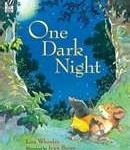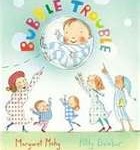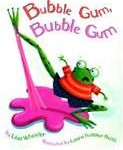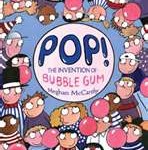Do You Know Which Ones Will Grow?
 Before I rave about Do You Know Which Ones Will Grow? by Susan A. Shea and Tom Slaughter, first I must rave about the public librarians in Washington. I just spent a day talking about great books and ideas with some of the most dedicated, hardworking, professional librarians I’ve ever had the pleasure to meet. These librarians do it all in their eastern Washington libraries, and I am inspired by them to do more when I get back to my library in Michigan.
Before I rave about Do You Know Which Ones Will Grow? by Susan A. Shea and Tom Slaughter, first I must rave about the public librarians in Washington. I just spent a day talking about great books and ideas with some of the most dedicated, hardworking, professional librarians I’ve ever had the pleasure to meet. These librarians do it all in their eastern Washington libraries, and I am inspired by them to do more when I get back to my library in Michigan.
But if I’m spreading the love this morning, I have to send some love to Susan A. Shea and Tom Slaughter for this book.
“If a snakelet becomes a snake, can a cupcake grow and become a (lift-the-flap) cake?”
How do I love thee, Do You Know Which Ones Will Grow? Let me count the ways.
1.I didn’t know they were called snakelets, so yay for learning vocabulary in context.
2. Nothing like lifting a flap to grab a young audience.
3. The flaps are actually sturdy enough to withstand multiple readings.
4. Love the rhyming practice we get to guess the right answer.
5. Half way through the book, we stop to get the answer (yes to these, no to those) and then we go to round two, which ends with a baby grows to become – you!
6. Tom Slaughter’s art is yummy.
This works wonderfully for the early science units on living and non-living things. An easy extension idea for non-crafty folks like myself is to give students a large piece of construction paper folded in half. At the top of the page, write “Do you know which ones will grow?” One one half of the page, write “Yes” and write on the other half “No”. Kids can choose die-cut shapes, or shapes cut from magazines, to glue on the appropriate side. Cute for a class book or a bulletin board, too. You know all your students will grow to love this book.
For more information, visit tomslaughter.com
Read MoreRetelling with file folder puppet theaters
 Kids retell stories all the time: they tell what they did over the weekend, what happened on the playground, who really put the building blocks in the fish tank, etc. Retelling is an important skill, and one fun way to retell a story is with puppets. I snagged this idea for making file folder puppet theaters off of this super-cool website: fairy dust teaching (Sally Haughey is one of those amazing teachers who has ideas I love to lift.) Cut windows in two file folders, attach them so you have a sturdy stand, decorate with scrapbooking paper, and ta da! Puppet theater! So now that folders are on sale for pennies a pack, I’m stocking up to make puppet theaters!
Kids retell stories all the time: they tell what they did over the weekend, what happened on the playground, who really put the building blocks in the fish tank, etc. Retelling is an important skill, and one fun way to retell a story is with puppets. I snagged this idea for making file folder puppet theaters off of this super-cool website: fairy dust teaching (Sally Haughey is one of those amazing teachers who has ideas I love to lift.) Cut windows in two file folders, attach them so you have a sturdy stand, decorate with scrapbooking paper, and ta da! Puppet theater! So now that folders are on sale for pennies a pack, I’m stocking up to make puppet theaters!
Puppet retellings work best with stories that have a limited number of characters and a straight-forward plot. One Dark Night by Lisa Wheeler and Ivan Bates is perfect for puppet theaters. One dark night, Mole and Mouse creep from their wee tiny house on a journey through the mush-mucky swamp, under sharp thistle thorns, into the marsh-misty wood. Meanwhile, a big giant bear in his big giant lair is feeling hungry. He leaves his den in search of food and finds Mole and Mouse. “Mole shivered. Mouse shook. Their fur stood up straight.” (Your listeners will be on the edge of their seats right about now.) The big giant bear towers over the wee beasts and grumbles, “You’re late!” Bear has been waiting for his two friends, who join him for a feast in his den.
Kids can make Mole, Mouse, and Bear puppets out of paper and popsicle sticks, and retell the story in their own table-top puppet theater! Or, if you’re lucky enough to have fantastic stuffed-animal-type puppets, put Mole, Mouse, and Bear, along with the book inside your Storybox and let the kids practice retelling that way, too.
Read MoreBubble Trouble
 “Little Mabel blew a bubble, and it caused a lot of trouble…
“Little Mabel blew a bubble, and it caused a lot of trouble…
such a lot of bubble trouble in a bibble-bobble way.
For it broke away from Mabel as it bobbed across the table,
where it bobbled over Baby, and it wafted him away.”
I double-dog dare you to pick up Bubble Trouble (written by Margaret Mahy and illustrated by Polly Dunbar) and not read this tongue-twisting treat aloud. If you are an educator, we can babble and gabble about phonological awareness, the power of interesting rhyme to help young listeners hear the distinct sounds in words and therefore be better able to decode those words on a page, but frankly, the most important reason you could ever have to share this book with a listener of any age is simply for the pleasure of the patter.
After you and your kids have giggled and goggled until your brains are boggled (oh Margaret Mahy, I love you so), it’s the perfect lead-in to a science experiment with bubbles. There are a variety of homemade bubble solutions – most with dish soap, some with glycerin, some with corn syrup – and how fun would it be to test different solutions, or to vary the amount of one of the components to see how the bubbles are affected? What happens if you blow harder or softer? What if you blow through a square-shaped hole – could you make square bubbles?
If you can get your hands on Mercer Mayer’s wordless book Bubble Bubble, you’d have two fun, distinctly different books about bubbles to compare and contrast.
(For those of you who may be fretful and upset-ful about the baby in the bubble, fear not: thanks to pink and purple patchwork, the rebel treble Abel, and a well-aimed pebble, the baby boy rebounded to his mother’s safe embrace.)
Read More
Chew on these great books
 In a recent Remenar Seminar, a principal pointed out that I share lots of stories, but not a lot of non-fiction. That’s something I’m working on – I love fiction, but I know many learners really respond to informational text. So, I’m trying to pair up books on irresistible topics – like bubble gum!
In a recent Remenar Seminar, a principal pointed out that I share lots of stories, but not a lot of non-fiction. That’s something I’m working on – I love fiction, but I know many learners really respond to informational text. So, I’m trying to pair up books on irresistible topics – like bubble gum!
I’m stuck on the bouncy rhyme of Lisa Wheeler’s Bubble Gum, Bubble Gum: “chewy-gooey bubble gum/ icky-sticky bubble gum/ melting in the road/ along comes a toad” who gets stuck. Then a shrew gets stuck, and more animals get stuck – until a truck comes along! What will they do? Chew! And blow a bubble that lifts them from danger, until…
This makes a terrific storybox. Put this book, with its great illustrations by Laura Huliska-Beith, and puppet characters on wooden sticks in the storybox with a container of homemade pink playdough (make sure it’s non-toxic because one of your sweetpeas will probably try chewing on it) to retell the story.
 Then, share Pop! The Invention of Bubble Gum by Megan McCarthy. It is excellent non-fiction for younger students. The topic is sure to grab their attention, the text is short but interesting and full of fun facts, and the illustrations are large enough for a group read. At the end of the book, McCarthy adds lots more information (like who holds the world record for largest bubble) for kids who want to really sink their teeth into the subject.
Then, share Pop! The Invention of Bubble Gum by Megan McCarthy. It is excellent non-fiction for younger students. The topic is sure to grab their attention, the text is short but interesting and full of fun facts, and the illustrations are large enough for a group read. At the end of the book, McCarthy adds lots more information (like who holds the world record for largest bubble) for kids who want to really sink their teeth into the subject.
Want a super-duper Dubble Bubble science extension? Ask your students, “Do you think bubble gum will weigh more or less after you chew it?” Use the scientific method of forming a hypothesis, listing materials and procedure, controlling variables (everyone chews the same kind of gum for the same amount of time), and see what your results are!
Read More






